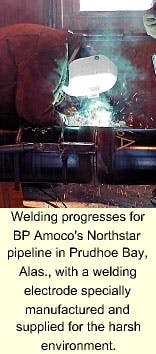A SPECIAL ELECTRODE WAS NEEDed for pipeline welding on BP Amoco's Northstar project at Prudhoe Bay.
The project required the Houston Contracting Co. to lay approximately 12 miles of 10-in pipe offshore in a total project of 33 miles connecting a man-made production island with the infrastructure of the Trans-Alaska pipeline.
One 48-in. OD, 0.562-in. WT segment crosses the Putuligayuk River.
The offshore line is being laid in water 3-40 ft deep and buried a minimum of 7 ft below the seafloor. Pipe is being welded in heated tents then laid through a slot cut in the sea ice by special trenching machines.
Completion is set for late May 2000.
Houston Contracting Co. tapped Lincoln Electric Co., Cleveland, to supply the electrode, its Shield Arc 80 product.
To ensure the electrodes could operate under harsh arctic conditions, Lincoln Electric teamed with distributor Airgas in Alaska to manufacture a special run of electrodes.
Manufacturing
Lincoln's Shield Arc 80 electrode is an 80,000-psi tensile strength consumable designed especially for pipe welding. Each diameter of the Shield Arc 80 was manufactured from one heat of steel and under controlled chemical composition, both of the steel core wire and the coating mixes, says Lincoln Electric.
Before leaving the Lincoln facility, internal testing of weld metal mechanical properties and X-ray soundness determined that the electrodes fell within the acceptance range and that they were certified to American Welding Society (AWS) A5.01 and A5.5 specifications.
The electrodes were then air shipped in hermetically sealed cans and special packaging to Alaska for testing that includes simulating the field welding conditions using liquid nitrogen to cool the pipe and then applying torsional flex tests.
In total, Lincoln supplied nearly 20,000 lb of electrodes in three diameters (3.2, 4, and 5 mm) for this project.



